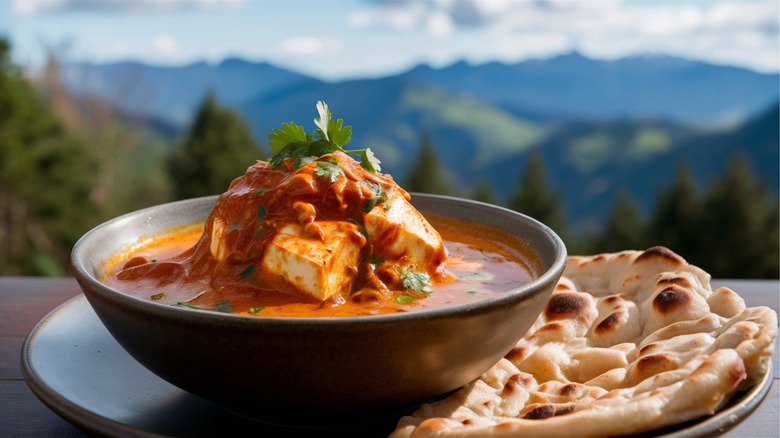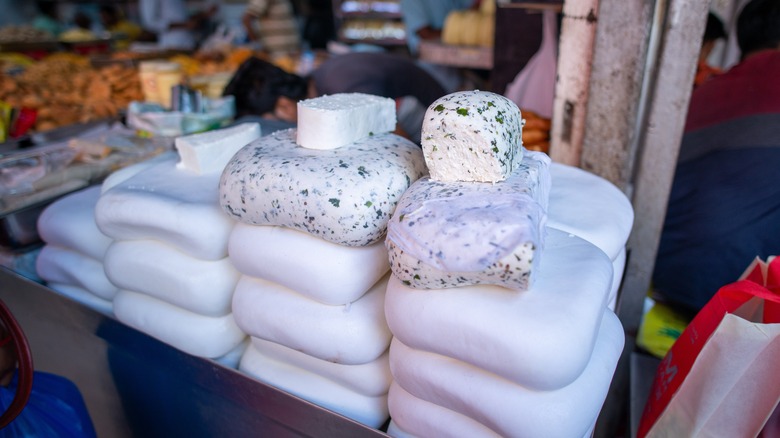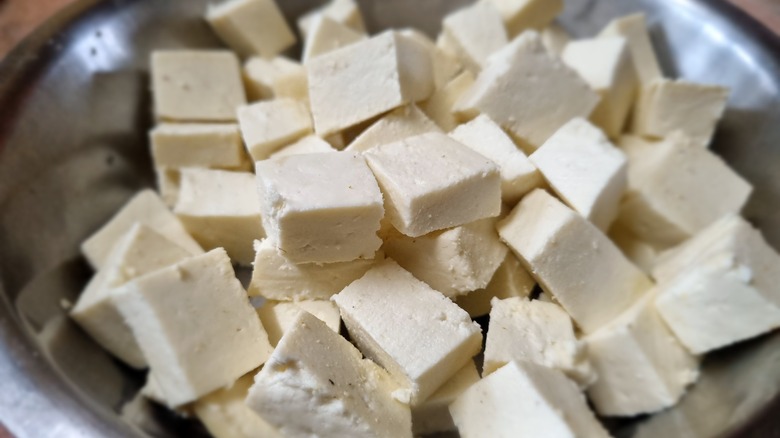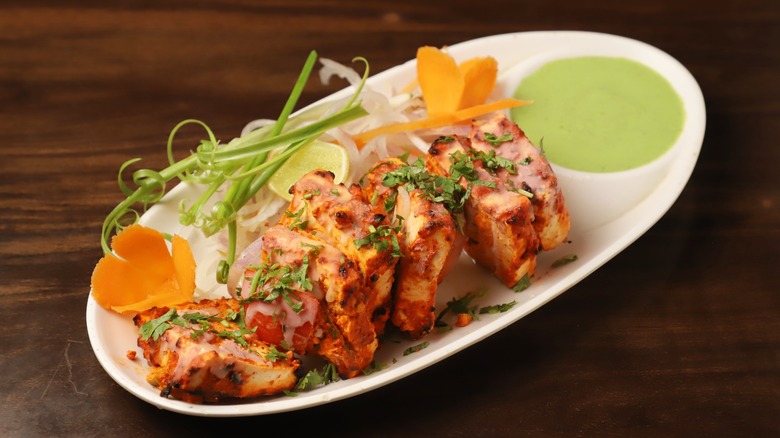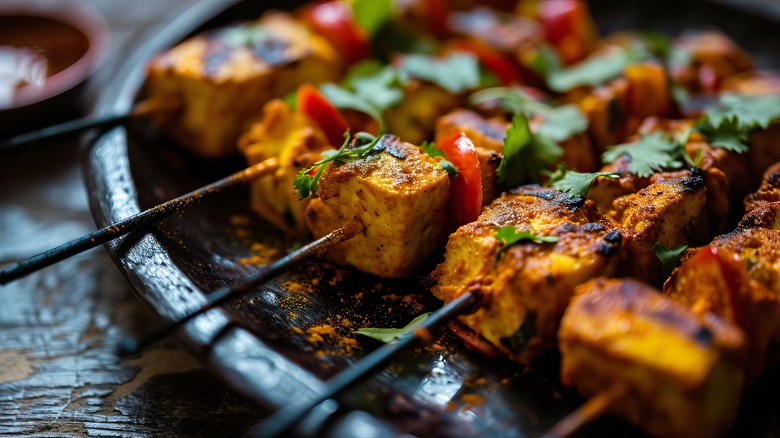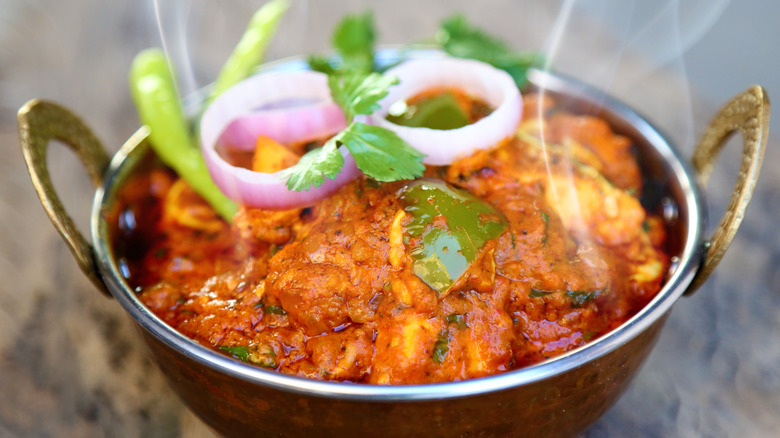An Expert's Advice On Cooking With Paneer
Cheese might not be the first thing non-Indian cooks think about when considering traditional Indian cuisine. In fact, there is at least one cheese that's pretty common: Paneer. The soft white curd cheese is somewhat similar to feta, cottage cheese, or Mexican queso blanco, and is popular across the Indian subcontinent. It's commonly cubed and cooked for curries and sauces. You might be most familiar with it in palak paneer, a curry of finely chopped spinach, onions, and cubes of paneer cheese. The mild and slightly chewy cheese is often cooked, rather than eaten on its own.
If you're just getting into Indian cooking (or want to incorporate paneer into other dishes), there are some tricks to getting just the right consistency when cooking it. Chowhound chatted with Varun Inamdar, owner and chef of three restaurants: 27 Degrees West in Singapore, Anokhi Bar and Grill in Shanghai, and New Light Sopore in Kashmir. He gave us some expert tips for cooking paneer at home and advice on incorporating the cheese into a number of popular dishes and cooking styles. Combine Inamdar's advice with one or more of the must-have Indian cookbooks out there, and you'll be an old hand at cooking with paneer in no time.
Go with fresh paneer when possible
As with most products, the fresher the better. Frozen, pre-diced paneer is available, but the texture is different. It crumbles and flakes easily, and can be rubbery when thawed. Frozen paneer works as a way to keep cheese on hand, but it should always be thawed before eating or cooking.
If possible, Varun Inamdar says to use fresh malai paneer, noting you'll get "better flavor and texture." Fresh paneer is available at specialty Indian markets, or online. The malai version Inamdar mentions has higher fat and lower moisture contents than some paneers, and is considered a good style for those new to working with the potentially fragile cheese due to its smooth, consistent texture and faster cooking time.
Of course, if you're up for it, you can also make your own. "Homemade paneer is easy to make and usually more delicious," says Inamdar. In addition to freshness, it provides the opportunity to add herbs and spices to customize the cheese.
Soak paneer in water before cooking
The worst thing that happens when cooking paneer (besides burning it) is ending up with a rubbery, dry final product. The cheese doesn't melt when cooked, which is why frying it works so well, but it can harden and get too chewy if prepared incorrectly, particularly with premade store-bought versions. Fresh homemade paneer is generally creamy and light, and is less prone to becoming rubbery. There's a fairly simple fix: soaking the diced cubes in water.
"If using store-bought paneer, soak it in warm water for 15 to 20 minutes before cooking," says Varun Inamdar. "This makes it softer and helps it absorb flavors better." Store-bought paneer in the United States is generally made from cow's milk, and especially benefits from soaking due to a lower fat content than the Indian versions made from water buffalo milk. Soaking it overnight works even better. Pat the outside dry prior to frying to reduce oil splatter.
Consider marinating for flavor
Most store-bought paneer consists of a block of acidified curds with no added flavors. But homemade paneer is often seasoned with herbs and spices. Paneer masala is a popular spicy version featuring cumin, chili flakes, coriander, and other seasonings. You can also buy inventive seasoned varieties like the organic spicy habanero paneer from Sach.
With unseasoned paneer, Varun Inamdar suggests marinating before cooking. "Marinate in spices, yogurt, or sauces for at least 30 minutes," he says, noting how it enhances the flavor of the cheese. You can also marinate in olive oil and lemon juice. Simply add the herbs and spices you want and a pinch or two of salt, coat or submerge the cheese fully, and refrigerate for up to two hours, mixing the cheese occasionally to fully coat. Marinating is a wonderful option prior to grilling paneer.
Prevent rubbery paneer by not overcooking
The next mistake many cooks new to working with paneer make is cooking it too long. It's important to remember that paneer is cheese. It can be eaten as-is, so the goal of cooking is simply to warm it and add a little color and crisp texture to the outside of each fried cube or grilled slab.
"Paneer cooks quickly," says Varun Inamdar. "Sauté it just until it's golden brown. Overcooking can make it rubbery." Whether pan-frying or grilling, the key is to not let one side sit too long on the hot surface. Use medium heat, and let the cubes sit just a few minutes on each side. Some people only fry two opposite sides of each cube or chunk, while others fry all sides for even color and crispiness.
The same holds true when grilling. You're hoping to get a good sear, but avoid overcooking. Depending on the heat on your grill, you're looking at about two to three minutes per side.
Don't be afraid to experiment
Paneer, much like tofu, is a versatile cooking ingredient. It's commonly used in curries, like the spinach version mentioned before, or paneer butter masala, a popular creamy tomato-based curry. But there are a lot of options. You can grill paneer chunks on skewers with onions and bell peppers like a kebab, or deep fry it like mozzarella sticks.
"Try different recipes," Varun Inamdar encourages. "Start with simple recipes like paneer tikka, paneer bhurji, or paneer stir fry to build your confidence." He suggests pairing the cheese with vegetables like peas, spinach, or bell peppers. Malai kofta, out of North India, combines paneer, potatoes, and spices into deep-fried, hushpuppy style balls, that are then soaked in a creamy gravy. Or get really creative, and try out Chowhound recipe editor Ryan McPhee's paneer panini with tikka masala jam. His creation evokes two sides of his family, merging toasty grilled cheese with his grandmother's paneer butter masala and tikka masala.
